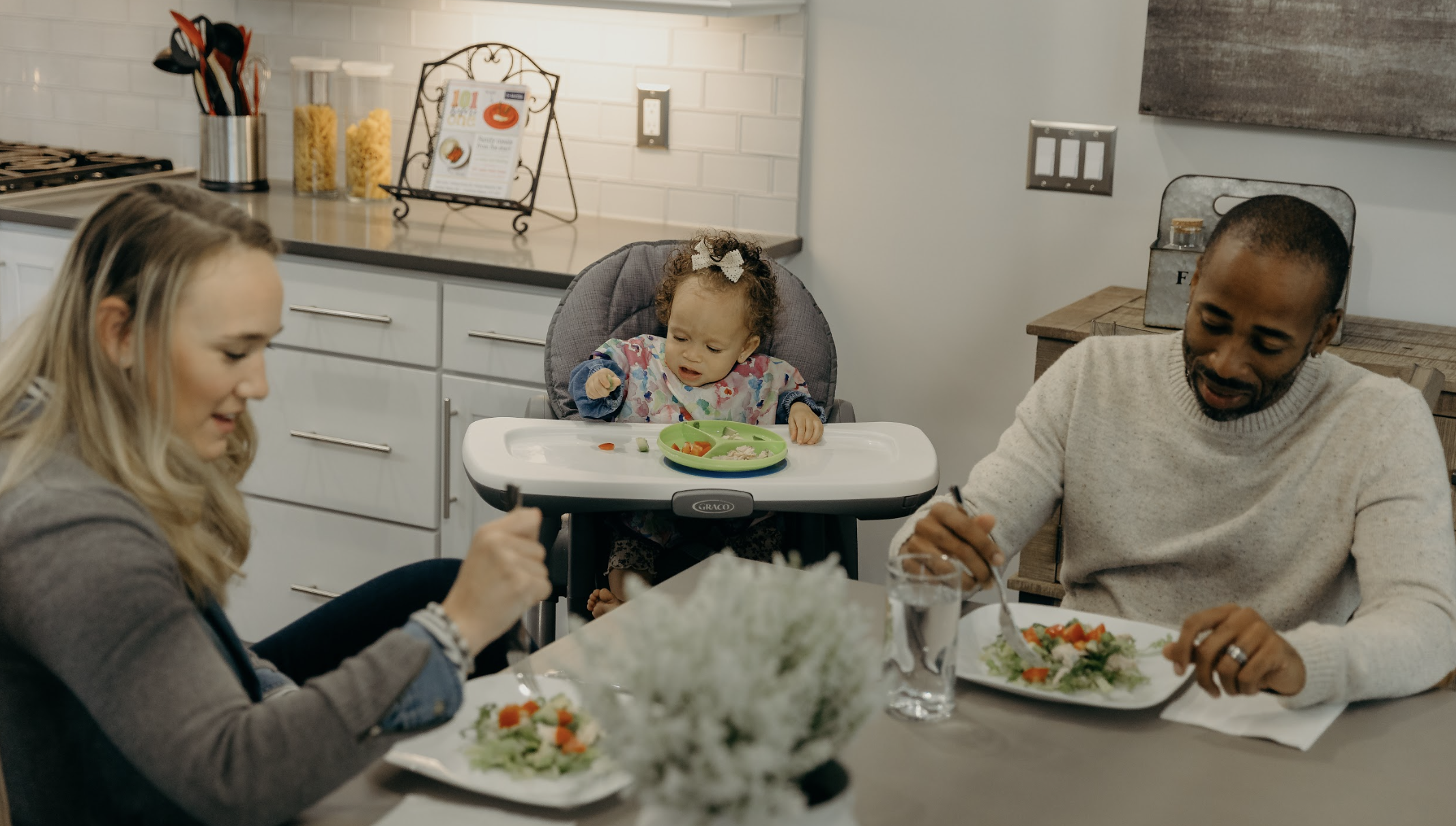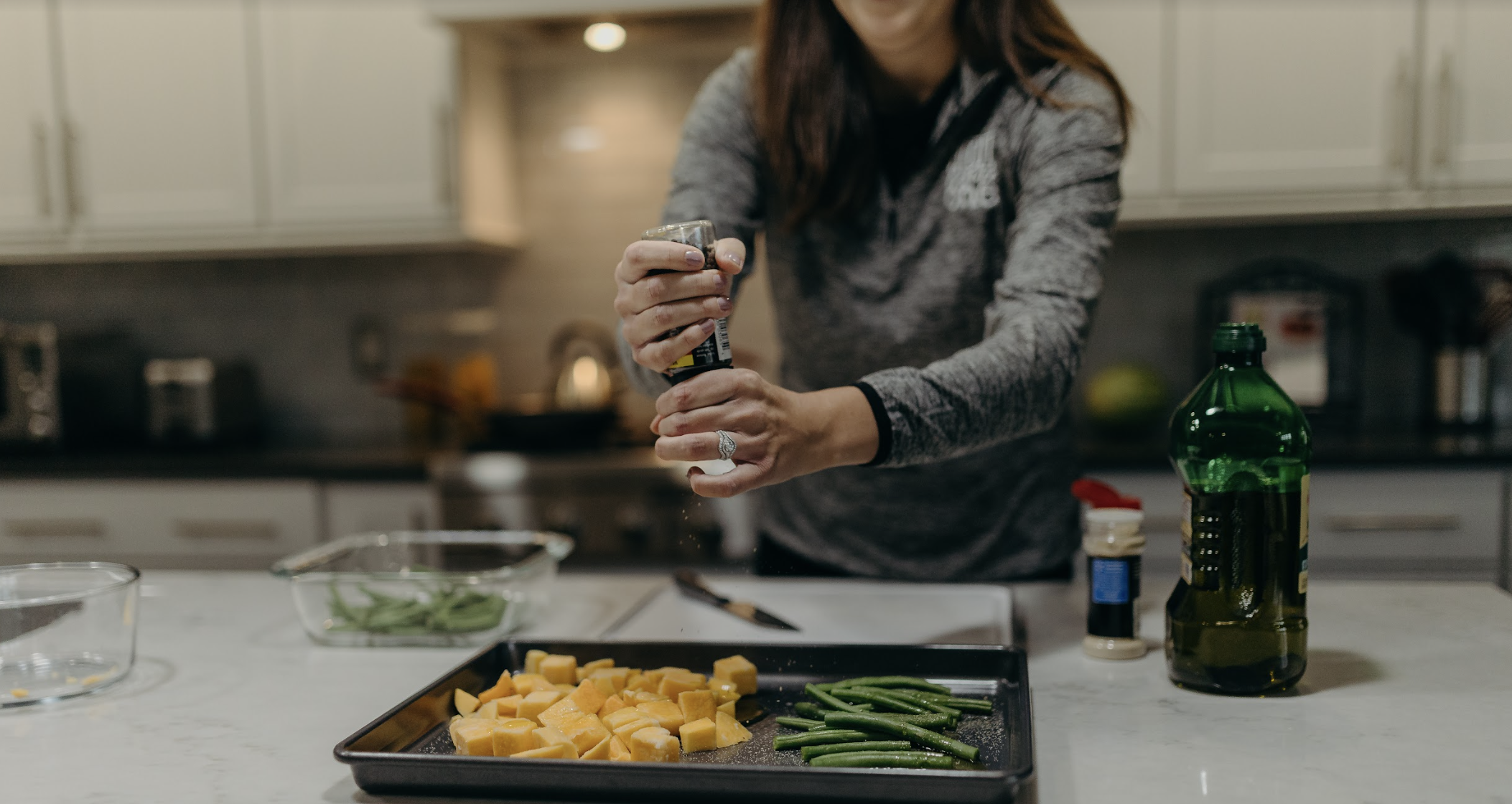How to Modify Family Meals for Baby
When it comes to baby-led weaning (BLW), the internet and social media have convinced parents that babies need special meals. Parents are searching online every day for “baby-led weaning recipes,” thinking that they need to cook three separate home-cooked meals every single day.
But in reality, the everyday meals they are already eating as adults can be easily adapted and served to their little one who is starting solids. The original intention of baby-led feeding was to have the parent cook a meal for themselves and then share that same meal with their baby (while modifying it for safety).
No longer do you need to cook multiple dishes for one meal. It’s time to embrace family meals again, and we at 101 Before One are here to show you exactly how to do that. Over 10,000 families have already followed our Family meals from the start program and are loving cooking one meal that feeds both their baby and themselves at the same time.
Read on to learn more about baby-led weaning, and then get access to over 200 baby-led weaning recipes!
When can babies eat the same food as the rest of the family?
Many toddler parents have a hard time getting their children to eat what the family is eating because they were raised eating separate meals. At 101 Before One, we advocate for Family meal from the start™. This means that we believe you should feed your baby the same meal the rest of the family is eating from day one of starting solid foods.
This not only saves time in the kitchen but relieves stress on the parent and allows them to take care of themselves, too. Parents inside our program report healthier eating patterns and lifestyles.
If your baby is just beginning to eat solids, we encourage you to think about the future. Is sharing family meals with your toddler something you want to do? If so, start serving your favorite family meals today (modified for your baby, of course). When babies grow up with the expectation that they eat what everyone else is eating at the table, they’ll never become afraid of “adult food.”
Get your baby on board eating family meals from day one. It takes a little creativity to come up with meals for your baby that both meet their dietary needs and are tasty for the adults, which is why we give you over 200 done-for-you meals inside of our program!
Why is it important to include my baby in family meals?
According to recent research, children learn about food through the direct experience of eating and by observing other people eating around them. Not only this, but it was found that children are more likely to eat a new food when they observe a model eating it, rather than simply being offered the food to eat. This is why we always push parents to eat with their babies, instead of just watching them eat.
Babies learn how to eat from the adults in their life! It’s important to model eating the same foods as the baby so they can become familiar with these foods. Try physically showing your baby how to pick up food, such as a green bean with your fingers, and place it on the side of your mouth. Then, let your baby mirror you. Also, expose your baby early on to unique dishes and flavors from various cultures. This allows them to develop a diverse palate early on and teaches them to appreciate food with a variety of tastes.
One important element of baby-led weaning is responsive feeding, which allows your baby to honor their hunger and fullness cues. When parents eat with their babies, it takes some pressure off. Parents can enjoy their meals, and the baby can decide on their own how much or what they want to eat.
What can I cook for both my baby and the rest of my family?
When beginning solids, it’s vital to focus on serving a variety of healthy and nutrient-dense foods. Inside our program, we go through our Balanced Meal for Baby framework, which includes iron-dense foods, fruits/vegetables, carbs/starches, and healthy fats at each meal!
So we know we’re supposed to serve family-style meals, but how do we modify a recipe to make it safe for babies as young as 6-12 months old?
Here’s our 3-step process to modify any recipe or meal for baby-led feeding:
Step #1: Check the ingredients
Don’t forget to take a peek at the ingredients to see if they’re baby-friendly when reviewing a recipe. There are some foods that babies can never have, including honey under the age of 12 months (because of the risk of developing botulism).
Also, avoid giving your baby any choking hazards. Hard, round, or firm foods are considered choking hazards for babies and should not be served. Some examples of foods to avoid include raw round carrots, raw apple wedges, whole grapes, popcorn, hot dogs, hard candy, and sharp foods like chips or pretzels. In addition, foods that are difficult to chew like marshmallows, melted cheese, cubes of tough meat, or globs of sticky peanut butter should also not be fed to babies.
For a full list of foods to avoid, head over to our Instagram page.
Salt
Although more research needs to be done on the maximum amount of salt infants can have, we go by the established AI of adequate intake levels. Per the Dietary Guidelines for Americans, infants 6-12 months have an AI of 370mg.
When cooking family-style meals for baby-led weaning we recommend not salting the dish or meal until the very end, when you can separate the adult portion from the baby’s portion. A little shake of salt turns out to be a lot of sodium! One dash of salt contains 155 mg of sodium and 1 tsp contains over 2,000+ mg.
In our house, we keep the salt shaker on the table for the adults to add to their meals. We do want to remind parents that sodium is an important nutrient in their diet (in moderation), but you do not need to be on a low-sodium diet unless directed by your doctor.
In addition to simply omitting added salt, you can also use low-sodium or no-salt-added packaged products. When it comes to packaged products, we suggest looking for less than 100mg of sodium per serving on the label.
To learn more about nutrition labels, read this Instagram post.
Some examples of some good low-sodium or no-salt-added foods…
✔️Stock/broth: Regular beef broth might have 1,000+ mg of sodium, whereas a low sodium version may have 90mg. Check the options at your local store.
✔️Canned beans and other vegetables: Buy “no salt added” beans instead of the normal variety, which has 300+ mg of sodium. Rinsing canned goods like beans can also remove some of the sodium.
✔️Nut butter: Many stores have their own store brand of nut butter, such as peanut butter, that contains 100% peanuts and has no added salt or sugar.
✔️Butter: Choose unsalted butter, or use either olive oil or avocado oil.
✔️Pasta: Avoid salting pasta water until after 12 months old.
Seasonings
Just because you should limit salt doesn’t mean you need to limit flavor! Common seasonings are just fine to add to your baby’s meal, such as dried spices or fresh herbs. You can even use garlic or ginger in your little one’s meal.
Take a look at this Instagram post on seasonings to find out more.
Sugar
We recommend avoiding added sugar, because according to AAP guidelines it shouldn’t be served to children under the age of 2 years old. While it’s easy to leave out the sugar in some recipes, other recipes require it. However, you can use natural sweeteners for babies such as unsweetened applesauce, bananas, dates, and prunes (puree only).
When purchasing packaged goods, look for labels that say “0g of added sugar.” The nutrition label may have two lines for sugar—one for naturally occurring sugars such as in yogurt, and another to show how much added sugar was added to that product.
Be careful, because even many “baby yogurt” brands have added sugar! Also, sugar is usually added to bread to help the yeast activate and rise. Look out for bread with a gram or less of sugar. “Sugar-free” foods usually contain artificial sugars which are also not recommended for babies or toddlers, so avoid these products as well.
Raw, unpasteurized, or mold-ripen foods
Raw, unpasteurized, or mold-ripen foods are also not suitable for babies when starting solids. When buying cheese, make sure the label says “pasteurized.” If serving meat, be sure to cook it to the appropriate temperature.
Step #2: Keep your baby in mind while cooking
Children under the age of 5 years old are at a higher risk for foodborne illness and therefore should not be served raw or undercooked foods. Become familiar with safe cooking temperatures and invest in an internal thermometer so you can always check the meat before serving.
Here’s a quick cheat sheet for you:
145°F
Pork
Lamb chops
Fish
160°F
Ground beef
Ground lamb
Steak and beef roasts
Baked egg casseroles
165°F
Ground turkey
Ground chicken
Chicken
Turkey
Until Opaque
Shrimp
Lobster
Eggs
Avoid serving baby raw, runny, or undercooked eggs. A good way to tell is if the eggs are no longer shiny, then they should be cooked through!
If there’s anything you like less cooked, it’s a good idea to cut and cook a separate piece for your baby. This way, your baby can have well-done meat and you can have your meat at your desired temperature!
Step #3: Serve dishes based on age and developmental level
From 6-9 months, babies have their palmer grasp, which means they pick up foods with their four fingers. The best-shaped food for babies at this age is either stick-shaped finger foods (like roasted zucchini sticks or long shreds of meat) or mashed foods (like cooked, mashed lentils) served on a loaded spoon.
Since babies don’t have teeth, the food should always be soft enough to easily squish between your fingers. It’s actually a myth that babies need teeth to start solids. In contrast, they don’t need any at all!
Some foods may be served as teethers and are not intended for consumption. By giving your baby a tough thick strip of steak, they can gnaw and suck on the juices, still gaining some nutrition but not really eating the piece of food. Some other examples of teething foods include mango pits and pineapple cores, which are perfect for oral motor development.
Around 8-10 months, babies develop what is called their pincer grasp. This is when they can pick up small pieces of food or objects with their thumb and pointer finger. At this time, you can transition to smaller pieces of food, about ½” in size.
For more information on how to serve food properly to your baby, check out our Baby Led Feeding 101 Online Course & Masterclass
Rather just have done-for-you recipes that are baby & family-friendly? Our Printed Book and Digital App have hundreds of family-style weaning recipes for you and your baby to share. From lasagna to chili to enchiladas to curry, we’ve taken over 200+ classic dishes and recipes and modified them for baby-led weaning! We’ve carefully selected all ingredients and even give you specific instructions for serving each dish by age and development.






